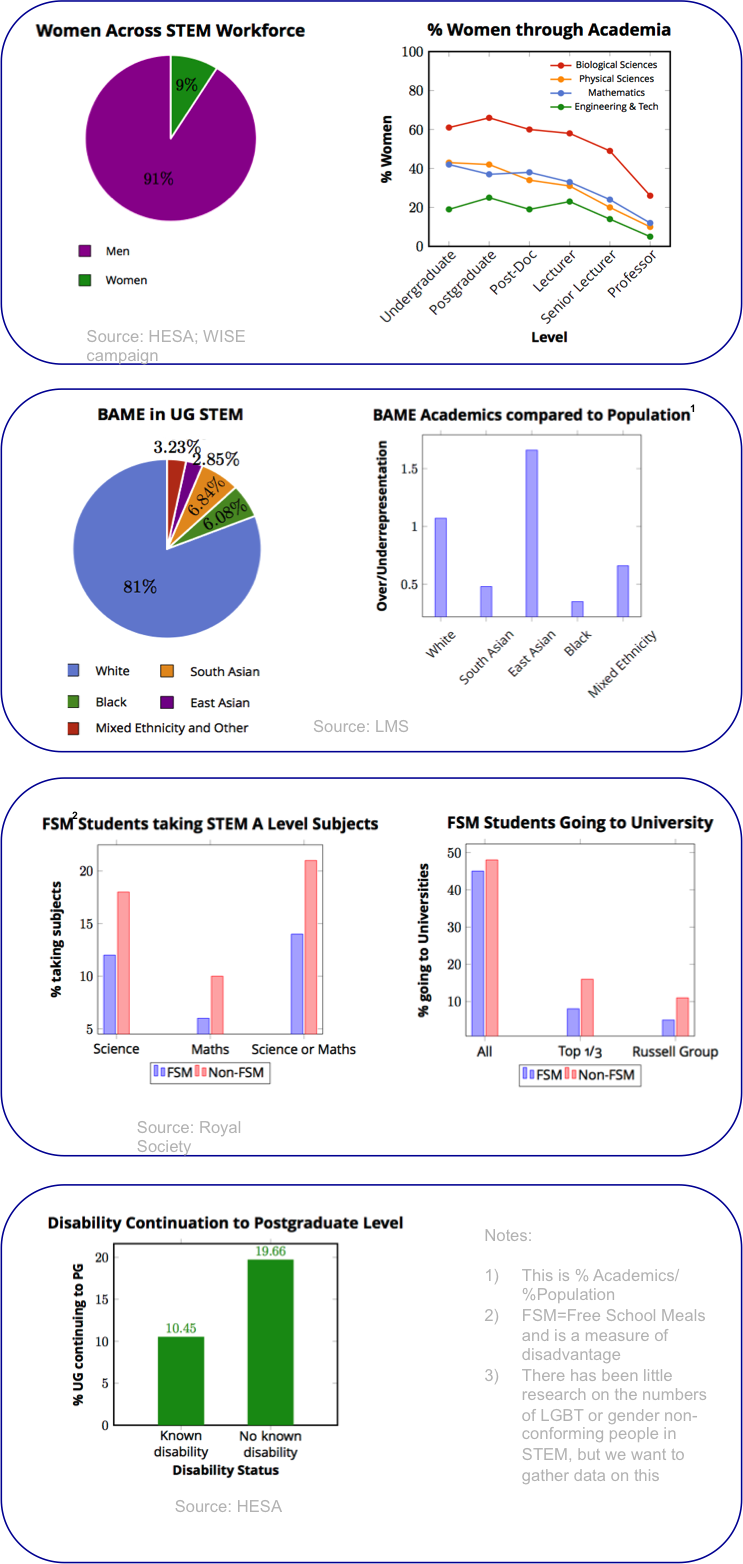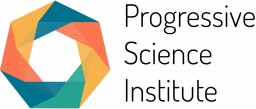Science transcends cultural and societal boundaries and will always thrive on collaboration between those with diverse backgrounds and views. Science, technology, engineering and maths (STEM) careers in this country are overwhelmingly dominated by white men, but science benefits from as broad a range of voices as possible.
In this article, we have tried to cover the main issues facing those who are underrepresented in STEM, but have not covered all the issues by any means. We want to hear people’s experiences from these groups at every level in STEM subjects, as well as suggestions to improve the situation. We have focussed on academia, but we would like submissions from all areas of STEM. We hope to crowdsource data, solutions and recommendations to make STEM a more accessible, inclusive place.
Diversity in STEM – as it stands
The current situation in the UK is illustrated below.

Many people believe that the discrepancy in numbers comes down to the choices of individuals. However, this neglects to recognise that choices are not made in a vacuum but in a society that shapes people’s experiences, opinions and self-image.
Indeed, if we focus on women, we can see that culture and society have a large influence on the numbers choosing science. The global comparison illustrates this: some countries are at 50% or more women, and Central Asia (46%), Latin America and the Caribbean (44%) and Central and Eastern Europe (40%) all outperform Europe and the US (32%).
The Challenges
Women, BAME people, people from lower socioeconomic backgrounds, people with disabilities and LGBT people face different and interconnected challenges at every level in STEM, as a result of implicit and explicit discrimination, as well as societal and structural pressures.
The issue of women in STEM has gained much attention and debate, especially recently in light of the Tim Hunt controversy. In the mainstream media, the focus has been taken from the concerns people have about women in science to the facts surrounding Tim Hunt comments and the subsequent events.
Challenges facing women include stereotyping from a young age as not being suited to STEM , including STEM-related toys and games being predominantly targeted at boys ; less confidence in STEM subjects despite ability; lack of female STEM role models ; raising a family within the high pressure ‘publish or perish’ environment of academia ; the male dominated culture of science and discrimination in relation to hiring and promotions . The combination of all of these is often referred as the ‘leaky pipeline’ from GCSE to Professor level as more women than men leave at each stage.
As well as explicit discrimination , women and minorities also face unconscious biases. This implicit discrimination has been identified in situations ranging from marking school exams to hiring choices. This year, a study was published that looked at maths scores of male and female school students, and found that girls did better when they were anonymised compared to when their names were on the paper, while boys did worse, suggesting an unconscious bias from the teacher. A similar American study found that black students were under-assessed while Asian students were over-assessed, relative to their white peers, when test papers were anonymised or not.
In 2012, a study showed that for applications for a Lab Manager role, CVs with the same qualifications and experience were more likely to be favoured when the name was changed from Jennifer to John. Scientists like to think of themselves as rational and objective, but they are just as susceptible to unconscious biases as the rest of the population, if not more so because of this assumption.
In parallel to the John versus Jennifer study above, more general studies have shown CVs with names associated with BAME people are less favoured over those with names associated with white people, although this was not STEM-specific. The lack of role models for BAME people, particularly black people, in STEM is a big issue, with many reporting feeling isolated and under pressure to represent their entire race or gender.
It is important to acknowledge the additional and specific challenges faced by those in more than one of the under-represented groups. Research from women working at the University of California, Columbia University and Goizueta Business School in America identified the ‘double jeopardy’ faced by women of color in STEM. They interviewed 60 women of color in STEM and collated their experiences, from a total sample of 575 women. 100% of the women interviewed had faced some form of discrimination, with 46% of women of color being mistaken for cleaning or janitorial staff, while they faced many other harmful stereotypes. In the UK, Black British Academics have highlighted the challenges in attracting and retaining black female students in STEM, including fewer role models, structural and cultural biases and unconscious biases from teachers.
Issues related to self-image have been shown to affect both girls/women and BAME people. On a maths test, when they were told gender differences had been found, girls did worse compared to when they were told there had been no gender differences (while boys did better). Similarly, when students were primed with their race, black students did worse compared to when they were not. However, East Asian students did better when identifying their race. This is often termed the ‘stereotype threat’ and highlights the interplay between society and achievement that different ethnic groups face.
Students from lower socioeconomic backgrounds can see STEM subjects generally and academia specifically as not for them. Schools in more deprived areas often lack specialist science teachers , which can affect subject choice. In the UK, in order to get on to PhD programmes, a Masters is usually necessary. Masters courses outside of the doctoral training programme can be prohibitively expensive and exclude many potential students.
Those with disabilities can face structural barriers to participation in STEM: from inaccessible buildings, to a lack of reasonable adjustments within labs, to the fact there doesn’t yet exist BSL for all scientific and technical terms, to the shortage of mental health support, etc. Despite high profile disabled scientists such as Stephen Hawking, STEM is not as accessible and inclusive as it should be.
There have been US based projects (OSTEM , LGBT STEM , NOGLSTP , Queer in STEM ) that have attempted to collate data, experiences and role models for LGBT people in STEM. A UK study on LGBT engineers found that a third hide their sexuality from colleagues, while 18% felt their sexuality had created barriers to their career progression. There are very few studies on LGBT in STEM and this is an area that requires more consideration.
There are clearly many and varied challenges affecting underrepresented groups in STEM. Below we have outlined potential solutions as well as indicated what has already been done.
Recommended Actions
There have been positive steps towards a more diverse science, including Project Juno and Athena Swan Awards for women in university science/physics departments, the STEM disability to collate support for disabled people in STEM, outreach projects to disadvantaged schools by university STEM departments and more.
These are a start, but must be adopted widely to have a significant impact and there is still more to do. Much of the focus has been on women, especially at the university level and beyond, but it needs to be broadened to all underrepresented groups. We also believe that the burden of diversifying science should not solely be on those from underrepresented groups to help others from their group: structural changes that involve everyone are needed. These could include:
- Unconscious bias training for all teachers, academics and people responsible for recruiting in STEM.
- Anonymous marking across schools, colleges and universities.
- Better outreach and public engagement with science.
- Double-blind peer review, which was shown to increase the number of female-authored papers in an ecology journal.
We want your contributions, especially if you are from a group or groups that are less well represented in science. This includes your experiences at school, at A Level, degree, postgraduate, post-doctoral, in industry and beyond. We are also interested in your recommendations for how to make STEM a better, more inclusive place for all.
